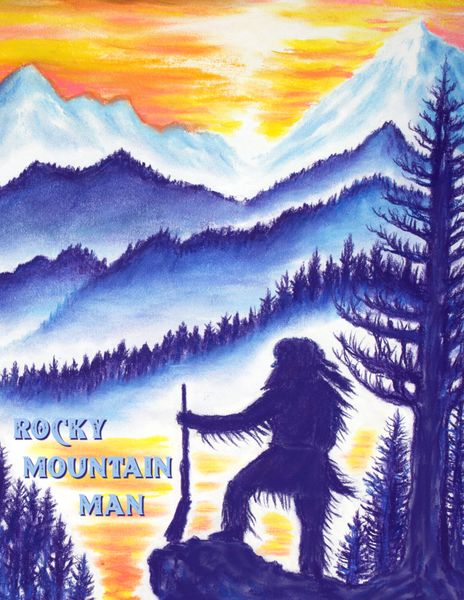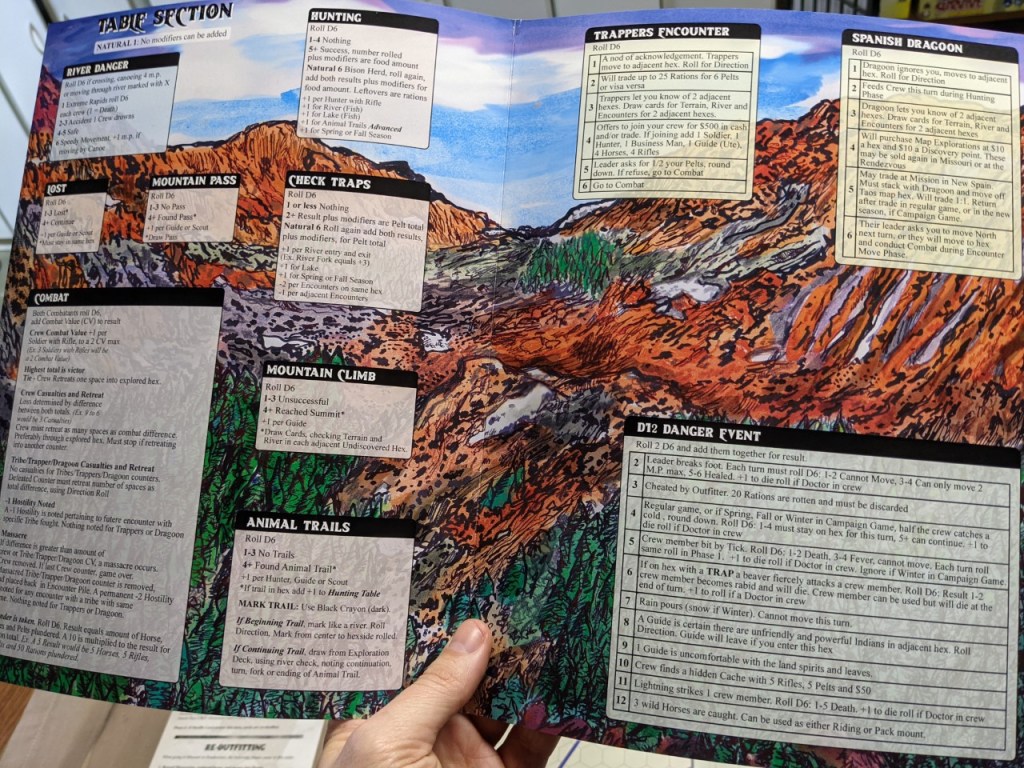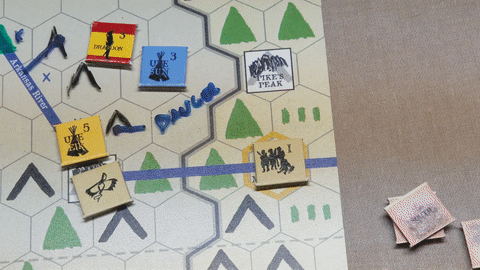Rocky Mountain Man is the latest LP from artist Nate Hayden. There are few principles chiseled into my bones, but blindly buying the new Emperors of Eternal Evil publication is absolutely one of them. I expected an interesting and weird experience. What I got was enlightenment.

It’s impossible for me to talk about this game without discussing the pandemic. Rocky Mountain Man hit at the end of 2020; a hellacious year that broke all of us. While I don’t doubt the gestation of this design began prior to COVID, the fallout of that virus certainly had a heavy influence on the development and framing of this release.
From the ground up this is a reflection of a unique cultural moment. It’s a solitaire game that has you sitting over a pale map with pale counters. As your small band of mountain men travel from Missouri and push into the Rockies, anyone watching would say it’s calm and almost anxiously quiet.
Yet within the magic circle of play it’s actually fierce. Your men will fall off cliffs and be mauled by bears. But even accounting for that bloodshed is a moment of silence amid a band of mutes.
There’s a sense of communion between player and game. This artifact requires construction by cutting out cards in preparation. In order to brace for the expedition you need to outfit your leader and crew, scrawling on paper as you hire guides, acquire horses, and allocate rifles. To then explore uncharted land you must mark up hexes with geography. You do this with crayon.
The whole thing is physical and primitive.

That relationship between player and game can be strenuous. It’s a demanding experience in both time and willpower. Part of that challenge is offloading the act of illusion entirely onto the participant. Whether you engage in just the two hour short expedition or the full blown 10 hour campaign, you will be the sorcerer burdened. The game does its part with meditative encounters and inspiring discoveries, but if you waver or lose focus it will begin to fall apart rapidly as immersion splinters. It’s very procedural and without the connective tissue of narrative those processes can begin to choke the wonder with repetition.
I also think the campaign game is the stronger option for this reason. With the shorter format you are almost entirely exploring new land and repeatedly hitting that deck. During the long game the incentives change from travel to commerce. This means you will engage more systems such as laying traps, scouting mountain passes, and visiting the rocky mountain rendezvous. Seasons and weather bear consideration forcing you to build a cabin during the winter to stave off death. The experience is more varied which results in an increasingly captivating narrative.
At its very core, Rocky Mountain Man is an extended series of table rolls. That’s true whether you’re actually rolling on one of a dozen included tables or drawing from the centralized deck, which essentially collapses a number of deeper resolution tables into one system. If you can’t get on with repeated table lookups interrupting and informing the play-state, then you won’t get on with Rocky Mountain Man. I’ve used the word table so damn much in this paragraph to highlight how fundamental that archaic process is here.

How about we take a look. To explore a new hex you draw a card. First you check if a perilous event occurs, such as a random soul in your group being bitten by a snake or trampled by moose. This may require a die roll or some bookkeeping on your roster. Then you draw a card for geography. After waxing up a hex with your Crayola (a euphemism this is not) you pull again to see if a river begins at this position. Finally, you draw one last time for a chance of encounter – this is where you may run into other trappers or Indians.
Let’s talk about those Indians.
The game carefully chooses this word to describe the indigenous peoples of the area. The rulebook poses a discussion of the term and you get a sense that Hayden went to great lengths researching this sensitive issue. He takes the time and space to detail his thought process and some of his findings. Outsiders were consulted and everything was done with purpose and care.
Encountering the tribes themselves is also a deliberate process. You are given the choice of trading, cheating, befriending, fighting, or ignoring the indigenous. Each is beset with a bit of nuance and can inform later encounters with that specific tribe. It’s a wonderful element of the game that adds to the overall depth and texture of play, helping to bulk up and affirm that narrative in the mind’s eye. These encounters can be tense, but they can also be joyful and surreal.
But those tables and dice rolls. The outcomes of your actions can be entirely unpredictable. At times it’s a capricious game despite providing ways to mitigate randomness – such as offering natives gifts of rifles to establish a rapport – but it can really kick you in the jaw. Due to a botched series of rolls I lost both my hunters not long into my very first journey. I wiped the blood off my lips, put my head down, and went back to work. Another time I randomly came across an enormous herd of buffalo. Their meat provided rations for days and my men were happy. This extreme fluctuation between decline and triumph is part of the allure here. It feels as if almost anything can happen.
That lack of control is not the full picture though. The very chassis of this game is a wide open sense of freedom. You choose how to build and outfit your starting crew. You decide which direction to take and which hexes to explore. You choose how to interact with Indians you encounter and which version of yourself you want to be. Even the objective of the game is framed by a decision point, as you choose whether to map the Colorado River or push to the Great Salt Lake. And that’s just the short version of play. The campaign ends when you gather enough resources to build a trading post – a task which can take place many years into the game’s timeline and is performed entirely at your discretion.
This sense of freedom is inherent to Rocky Mountain Man. It’s a game about seizing opportunity and confronting nature, but it’s also about our decisions setting things in motion only to find them spiraling out of control. After a year of captivity it’s liberating to play a game focused on escape and overcoming the environment in pursuit of destiny. These are the work’s strongest themes and what it says about our autonomy must be viewed through the current crisis.
With so much out of your control, you have to make peace. You have to deal with what’s been given and not what could have been. Like that time my leader stumbled when crossing a waterfall and disappeared over the edge. I spent two days travelling downstream looking for the body. It felt like the right thing to do.

Note – dry erase was utilized for increased visibility
I used the word archaic earlier and I mean it. Similar to the bygone prose of Cormac McCarthy, Hayden chose this format with care. Much of the design was influenced by the ancient Avalon Hill title Source of the Nile. That similarly crayon-based expedition game was released in 1978 and is only now being directly referenced and established as an influential relic. It highlights that the greater experience here is looking inward at our past and who we used to be, whether that be the game’s pre-existence or our own.
As I said, this experience has been enlightening. There’s a level of intimacy here with our pre-COVID selves. It’s amusing that this intimacy was gained through quiet introspection over a mess of cardboard.
However, I wasn’t amused. What this reflection lead me to was somewhat unsettling.
One attribute which has repeatedly drawn me to this game is a projection of masculinity. There’s an allure here of ruggedness, survival, and dominance over nature and God. In leaving civilization behind I’m diving into the abyss and overcoming my shortcomings and inadequacies.
As I move hex-to-hex and chart new land it feels as though I’m in control, even if that’s deception. Running into unforeseen challenges forms the building blocks of a mythology I’m scribing, stroke by stroke. It feels powerful. It feels masculine.
And this reverberates deeply with my own issues of manhood. I’ve never measured up to what I should be. As a man who is only five feet and five inches tall, I’ve gotten used to feeling small. As a man who has shouldered part of the blame for marital fertility issues, I’ve gotten used to feeling inadequate. I’ve known these things but I haven’t previously tied them so strongly to my experience on the tabletop.
I’ve played board games for nearly 30 years of my life and it took a little folio from Nate Hayden to wake me up. Perhaps I didn’t want to look it in the eye, but Rocky Mountain Man made me realize that I’m attracted to power fantasies such as Warhammer and Conan in pursuit of something ingrained into the male identity. Something that feels missing within myself.
It’s not surprising these narrative-driven fantastical games convey strength, or even that this would appeal to a boy, but it is personally surprising that I latch onto these designs because I have such a gaping void in my existence.
Rocky Mountain Man isn’t just a game. Rocky Mountain Man is the idealized version of myself, even if that self is not truly ideal. And it’s all momentary, wiped away with a bit of cloth like smoke in the wind.

I’ve wrapped myself in this game’s masculinity like Leonardo Dicaprio crawling into a hollow horse for warmth. Rocky Mountain Man’s narrative has affected my own.
I lay awake at night thinking about these things and thinking about Rocky Mountain Man.
If you enjoy what I’m doing and want to support my efforts, please consider dropping off a tip at my Ko-Fi or supporting my Patreon.

gotta say, I let out a “damn” at the last part. Charlie Theel’s getting his Call from the Wild (heh).
As someone who has toxic masculinity ingrained into him (at least in terms of the weird expectations that I also fail to live up to), it’s super interesting introspecting on that aspect in a more “feels” way, as opposed to just stopping at the cringe response I get from the superficial aspect of it, like seeing the typical burly men and scantily clad chicks on a board game cover (if that makes sense).
That said, it’s interesting to think about what the masculinity thing means today. For some, it’s being good at picking up chicks at the club, for others, it’s being able to at least be able to build a shed. I’ll always think of all of the rough and rowdy tales of my pops and uncles though (some wild west shit it is being natives from the 50s) and this game feels like it sort of digs a bit deeper and reflects a bit more on that.
Otherwise, I’m surprised that I hadn’t heard of any comparisons to that computer game Oregon trail. The whole thing just really reminds me of that (at least how the encounter tables seem to line up with the random events of that game).
Loved your take on it! Currently waiting mine up in Canada.
LikeLike
Exploring this masculinity with a crayon is just genius!
LikeLike
Thank you for reading and for the thoughtful response. I could have wrote a great deal more about masculinity and the game, but I didn’t want to overwhelm the piece with that and make it about toxic masculinity. I think I hit my mark of letting it linger with the reader as opposed to offering a burdening discourse.
Oregon Trail is a good comparison! I’m not sure why as I played a bunch of Oregon Trail as a kid, but that didn’t really come to mind here. Maybe because that is firmly a digital game which I feel less personally attached to or immersed in? That’s also a more humorous game (“I died of dysentery!”) whereas I didn’t get a lick of humor from Rocky Mountain Man.
LikeLike
Well … I have tried crayon rail-builder games in the past … Iron Empire or something … its been decades so I forget the exact name, but I was not impressed.
The components on this seem like they are from decades ago.
I would not normally have looked twice at something like this even though I am a Cave Evil fan like you are.
However, you make it sound so interesting.
I will look into this AH looking crayon game further (he said – barely believing the words that were coming out of his mouth… in this golden age of Fantasy Flight/CMON/GF9/Petersen Games components).
As for the masculinity issue … we are in a period of PC’ness like never before. Some of that is good and some of that is bad. We should be … blah blah blah … and we shouldn’t be … blah blah blah.
I don’t mean to make light of any issues, I just am tired of not being able to discuss them in good faith without immediately being cancelled out.
I don’t think we as men need to walk on eggshells when it comes time to do something that is seen as overly masculine.
I would rather take the approach of enjoying the experience, but leaving it open for any women out there who want to strangle a bear to death with their bare hands, go skinny dipping in a freezing mountain stream trying to catch a trout for dinner, and/or knife fight to the death a claim-jumper who is approaching you with a sharp shovel and a murderous gleam in their eye with no help for 100 miles in any direction.
Maybe we just need different words for certain things in our lives these days as so much baggage is tied to words like “masculinity” ….
Maybe if we just called it “Stupidly Aggressive Outdoorsmanship” or something like that it wouldn’t trigger people the same way.
anyway – I’m glad you are enjoying it and I will have to check it out now so thanks!
LikeLike
This is VERY different than a crayon rails game Ian, besides of course marking on a map with crayons. The components are very lo-fi, but this fits right in with Nate Hayden’s other magazine games – Psycho Raiders, Sea Evil, Freakface!!!
I don’t think this game is necessarily focused on masculinity. It never uses that word and approaches the material more from a historical perspective. That’s simply how I connected with it, much like how the interpretation of art is left to the viewer.
That’s also why I left the commentary near the end, as I didn’t want to phrase the entire review around that discussion, as others may not connect with it in the same way. I did think it was pretty special though that a game could connect with me on that level, as those tend to be the most interesting experiences in my opinion.
LikeLiked by 1 person
and its sold out … hmm…
LikeLiked by 1 person
Yeah, unfortunately I think it sold out in the past couple of days. Doh.
LikeLike
Alright – I’ll watch for a copy to show up on ebay. Or if you get tired of strangling bears and want to move on your copy let me know! 🙂
LikeLike
Googled “Rocky Mountain Man Review” read this, was amazed, then noticed it was Charlie Theel in the comments. Nice, nice review.
LikeLiked by 1 person
Thanks Cran!
LikeLike